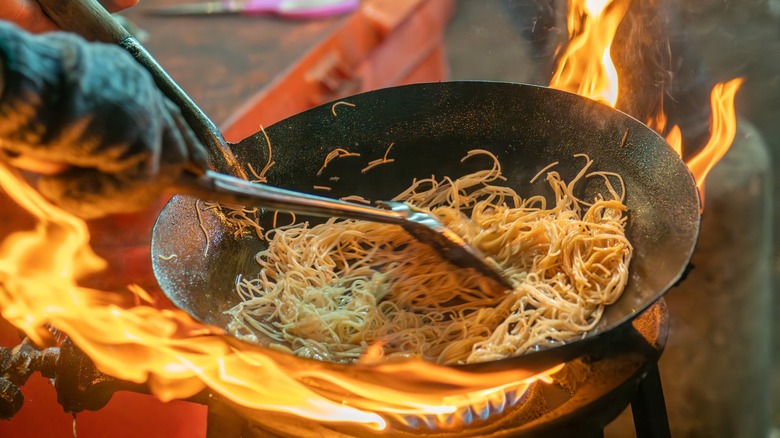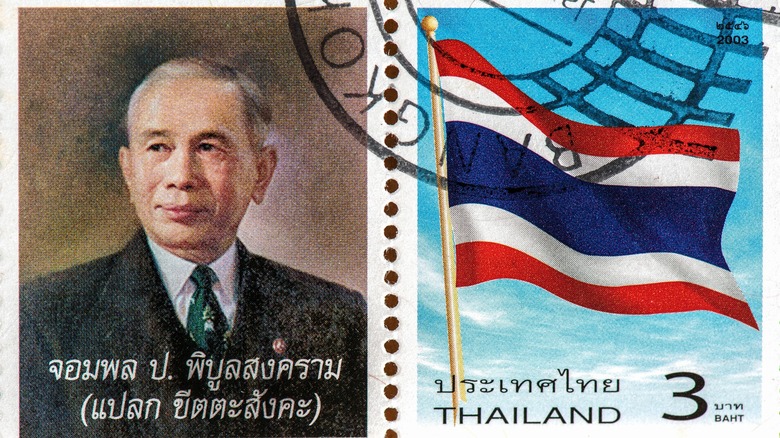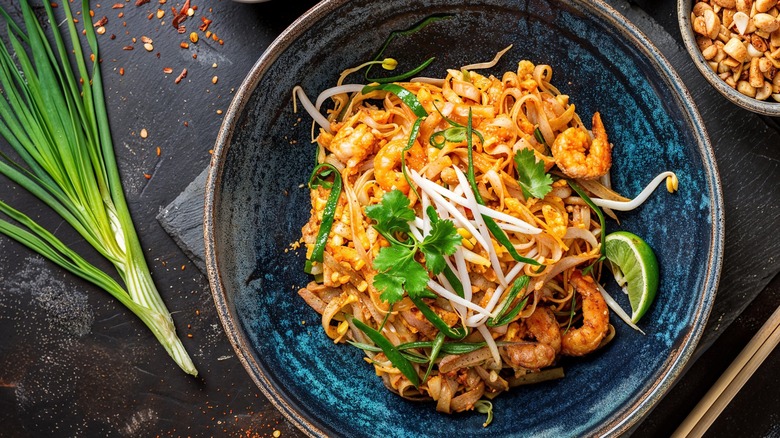Did A War Really Help Promote Pad Thai?
Pad Thai always stirs up a whirlwind of sensory and visual delights: Fiery flavors flaring up in a scorching hot wok, tossed by the street vendors who capture the lively, chaotic spirit of Thailand. It's a dish as bold as the country itself — hot and steamy like the bustling streets, with tuk-tuks zipping through the traffic, neon lights flickering, and the thick aromas of spices permeating the humid air. Every bite of pad Thai bursts with a generous blend of salty, spicy, sweet, umami, and tangy, capturing the essence of the region's frenetic energy.
Pad Thai, which means "Thai stir-fry," remains one of the most symbolic of the region's dishes. It serves a purpose in food culture far beyond being a plate of deliciously filling noodles and a popular takeout option. As celebrity chef Andy Ricker noted in an exclusive interview with The Takeout, understanding its history provides fresh new perspectives that help to appreciate this meal.
Although pad Thai is one of the most well-known Thai dishes worldwide, few realize its origins are not rooted in family kitchens passed down through generations. Instead, its rise to fame is intertwined with the country's immigration stories, wartime propaganda, and bureaucratic initiatives. This iconic meal reflects a moment of political turmoil and the nation's effort to forge a collective identity through food. Its popularity surged during World War II under the wartime strategy of Prime Minister Plaek Phibunsongkhram, also known as Phibun, who held power from 1938 to 1944 and 1948 to 1957.
Pad Thai's rise: The wartime campaign that made it national
Noodles became popular in Thailand in the 18th century when Chinese traders introduced it along with wok cooking techniques. Over time, they were adapted to Thai tastes using local flavors like tamarind and fish sauce, and wheat noodles were replaced with rice noodles. However, cooking with rice noodles didn't become a significant part of the country's cuisine until the 1940s, when Phibun seized power and decided to incorporate pad Thai into his political campaigns.
An undeniable effort that promoted pad Thai was Phibun's "noodles for rice" strategy. During World War II, Thailand faced economic hardship and a rice shortage that was exacerbated by destructive flooding. In response, the military dictator launched a strategic campaign to conserve rice by promoting rice noodles as an alternative, since a single bowl of rice could be stretched to produce two bowls of rice noodles. With the widespread catchy slogan of the "Noodle is your lunch," the campaign framed eating pad Thai as a patriotic act and emphasized its practicality, affordability, nutritional value, and ability to help the nation stretch its rice supplies.
In this effort, pad Thai, made with rice noodles and an assortment of vegetables and proteins, emerged as a vital solution by offering a cheap, complete, and satisfying meal. The government even distributed free noodle carts and recipes to promote the dish across the country. However, questions remain: Why did Phibun's government choose pad Thai specifically, and who originally created this dish?
Pad Thai: Redefining Thailand's national identity
The "Noodles for your lunch" campaign was more than a wartime response — it was key to Phibun's plan to modernize Thailand and forge a new national identity. Despite rumors of pad Thai being a state invention, Phibun's son recalled in a Gastronomica journal article that the dish originated in their family home, possibly created by a hired cook or aunt and inspired by an old Chinese recipe. Whatever its true origins, it brought something entirely new and distinct to the Thai culinary landscape, which is precisely what Phibun needed for his new national dish. From there, his government began to distribute a standardized pad Thai recipe to ensure that the whole country adhered to the unified national taste under his rule.
One thing, however, remained strikingly obscure and ironically contradictory. As noted by Mental Floss' Michele Debczak, although Phibun championed the exclusive use of Thai ingredients under his programs, the dish features global additions like mung beans, peanuts, and chili peppers. Even more paradoxical, pad Thai's roots lie in Chinese culinary traditions, making its "national" status all the more conflicting.
Whether Phibun overlooked this discrepancy or made a deliberate choice remains unclear. Whatever the reason, he succeeded in establishing pad Thai as a national dish in Thailand, even though he was later overthrown in 1957 and died in exile in Japan in 1964. Could he have imagined that it would become such a global sensation? That remains a mystery.


